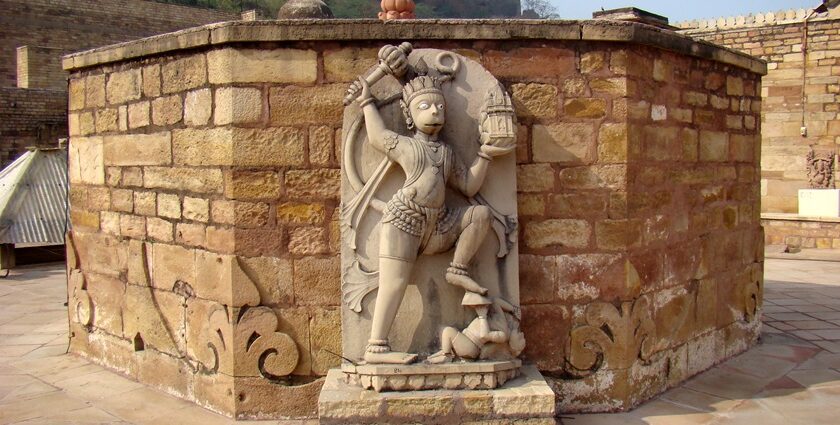The Gujari Mahal Archaeological Museum is a treasure trove of historic relics and gives an in-depth look into the history of India’s regal past. It is situated in historic Gwalior, a part of the magnificent Gujari Mahal that was built in the 15th century by the scion of Rajput clan Raja Man Singh Tomar for his beloved queen, Mrignayani. It houses a wide array of sculptures, coins, weapons, and other remains that glue together to encompass the cultural and artistic genius of diverse dynasties.
Gujari Mahal Archaeological Museum Location
Photo: Kmohankar / Wikimedia Commons
The Archaeological Museum stands in the middle of Gwalior, Madhya Pradesh, inside the Gwalior Fort. The museum is easily accessible from any point in Gwalior and therefore, serves as an added stop on your itinerary covering various historical destinations in Gwalior. In fact, If you’re wondering where is Gujari Mahal Archaeological Museum, it’s right within the Gwalior Fort precinct, a well-known and frequently visited destination.
How To Reach Gujari Mahal Archaeological Museum
Photo: Yeeshu78 / Wikimedia Commons
To reach Gujari Mahal Museum is simple and easy due to its central location. Here are the primary modes of transport:
By Air: The nearest airport is Gwalior Airport, and Gujari Mahal Museum is 14 km away. One can access the said places through a taxi or a hired cab, and it will take about 30 minutes to reach them.
By Bus: Gwalior has a good roadway transit system, and regular bus services are operated from cities like Delhi, Agra, and Jaipur. The museum is some 4 km away from the Gwalior bus stand. Locals can avail themselves of local buses, rickshaws, or taxis for the short ride.
By Rail: The Gwalior Junction railway station is one of the major railway nodes in the region, and it is 6 km from the museum. The city is well-connected with major Indian cities through various trains. From here, either take a taxi or an auto-rickshaw to reach.
Places To Visit In And Around Gujari Mahal Archaeological Museum
Exploring the Gujari Archaeological Museum and its surroundings offers a plethora of historical and cultural experiences. Here are some must-visit places:
1. Gwalior Fort
Photo: Anuppyr007 / Wikimedia Commons
The fort at Gwalior is one of the most magnificent and historically important forts in India. It has long witnessed innumerable battles besides being ruled by different dynasties. Rich in detail for architecture, the fort offers panoramic views of the city and houses various palaces, temples, and water tanks within its walls. Other main attractions, within the fort, are the Man Singh Palace, the Gurjari Mahal, and the Jain temples. No visit to Gwalior would be complete without taking in this imposing historical wonder.
Timings: 6 AM – 5:30 PM
Entry Fee: ₹75 for Indian nationalsc, ₹ 250 for foreign nationals
2. Sas Bahu Temples
Photo: Anupam Mukherjee / Wikimedia Commons
The Sas Bahu Temples are two twin wonderful temples part of the Gwalior Fortress complex, built in the 11th century. Despite their name, they are dedicated to Lord Vishnu. The architectural designs of these temples-which illustrate different stories and scenes from Hindu scriptures-are renowned for their beauty. Sas and Bahu are two feats of architecture: the bigger, Sas, and the smaller one, Bahu. These temples provide the visitor with a quiet retreat and are ideal for art and culture enthusiasts.
Timings: 9 AM – 5 PM
Entry Fee: Free
3. Teli Ka Mandir
Photo: Ms Sarah Welch / Wikimedia Commons
Regarding architectural history, the Teli Ka Mandir inside Gwalior Fort is an architectural marvel from the 9th century. This temple is distinctively an architectural blend between both Dravidian and North Indian architectural styles. It is a particular type of shrine built exclusively for Lord Vishnu but later started changing into a Shiva temple. The temple has a high spire with intricate carvings of the gods and a typical gopuram entrance that is one of the most imposing and striking structures within the fort.
Timings: 9 AM – 5:30 PM
Entry Fee: Free
4. Tomb Of Tansen
Photo: Amit Sen / Wikimedia Commons
Located not very far from the Archaeological Museum in Gwalior, the Tomb of Tansen is dedicated to Tansen-rendezvous musician and one of the “Navratnas” in Akbar’s court. This aesthetically pleasing yet modest tomb is situated within a lovely garden and is a historically important monument. The most frequently organised festival here is the Tansen Music Festival, which attracts classical musicians from the length and breadth of the country every year.
Timings: 8 AM – 6 PM
Entry Fee: Free
5. Jai Vilas Palace
Photo: Suyash Dwivedi / Wikimedia Commons
Located in the city of Gwalior, the Jai Vilas Palace is a fine example of European-inspired architecture, built in the 19th century by Maharaja Jayaji Rao Scindia. The palace is still the residence of the Scindia royal family, with a portion converted into a museum open to the public. The museum displays a vast collection of artefacts, paintings, and antique furniture that showcase the lavish lifestyle of the Scindias. The centrepiece of the palace is the grand Durbar Hall, adorned with massive chandeliers and gold furnishings.
Timings: 10 AM – 5 PM
Entry Fee: ₹300 for Indian nationals, ₹800 for foreign nationals
Where To Stay
Photo: Pixabay / Pexels / Image For Representation Only
When visiting Gwalior, you’ll find a range of accommodations, from budget hotels to luxury resorts. Some of the recommended places include Taj Usha Kiran Palace for a luxurious stay or Hotel Gwalior Regency for a more budget-friendly option. Most hotels are centrally located, offering easy access to the Gujari Mahal Museum and other landmarks. Whether you’re after comfort or convenience, there’s something for everyone.
Where To Eat
Photo: Pixabay / Pexels / Image For Representation Only
The food scene in Gwalior blends traditional Indian cuisine with local flavours. You can find delicious meals at places like Indian Coffee House, a short distance from the Gujari Mahal Museum, which offers budget-friendly options. For a more upscale dining experience, head to Silver Saloon at Taj Usha Kiran Palace, where you can enjoy gourmet cuisine with a royal ambience.
Best Time To Visit
Photo: Pixabay / Pexels / Image For Representation Only
The best time to visit Gujari Mahal Archaeological Museum is during the cooler months, from October to March. The weather during these months is pleasant and ideal for exploring both the museum and other nearby attractions. Summer temperatures in Gwalior can soar, making outdoor sightseeing uncomfortable, while the monsoon season may hinder your plans with unpredictable rains.
Other Factors To Consider
Photo: CR Shelare / Wikimedia Commons / Image For Representation Only
Average Cost Of The Trip:
A trip to Gujari Mahal Museum can be quite affordable. For a budget traveller, the cost, including transportation, accommodation, and meals, may range from INR 3,000 to INR 5,000 per day. For those looking for a more luxurious experience, the cost can go up to INR 10,000 or more daily.
Tips For Travelers:
- Make sure to carry water and wear comfortable shoes as exploring the Gwalior Fort and Gujari Archaeological Museum requires walking.
- Photography is allowed, so don’t forget to capture stunning photos at Gujari Mahal Archaeological Museum and around Gwalior Fort.
- Check the Gujari Mahal Archaeological Museum timings before planning your visit to avoid disappointment.
- Try to visit early in the day to avoid crowds and make the most of your trip.
The Gujari Mahal Archaeological Museum is not just a museum but a gateway to the rich cultural and historical heritage of India. Its collection of artefacts and the beauty of its architecture make it a must-visit destination for history enthusiasts and travellers alike. If you’re planning a trip to Gwalior, be sure to include the Archaeological Museum in your itinerary. To book a hassle-free trip, visit TripXL and get started on your historical adventure today.


 WhatsApp
WhatsApp
 Twitter
Twitter



